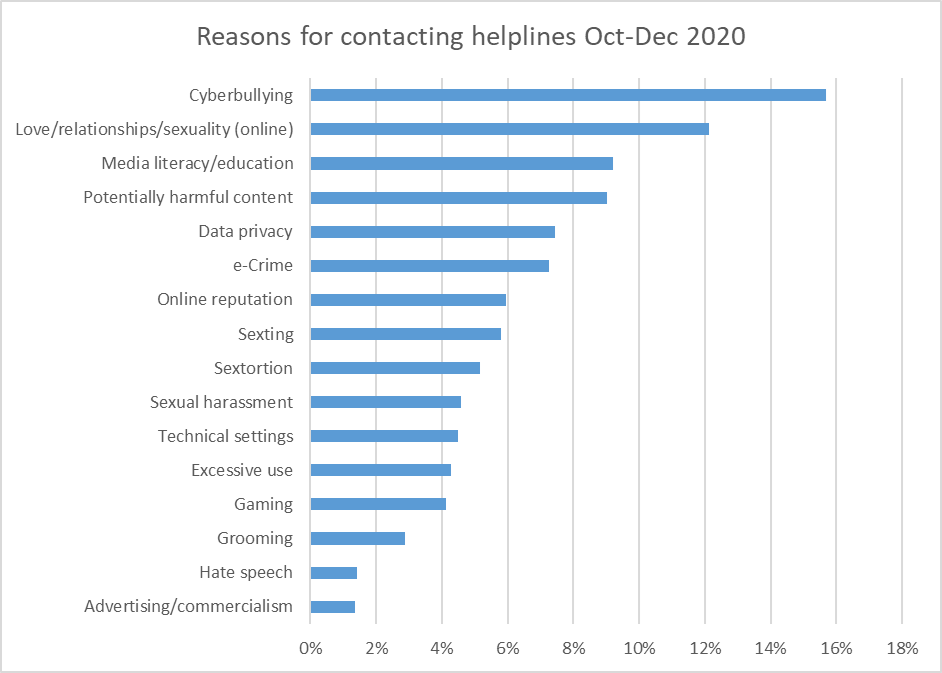The Insafe network of helplines collects data about the types of calls received and this is analysed every three months to look at trends, and new and emerging issues. The most recent helpline data covers the period from October to December 2020 inclusive and also provides some comparisons between 2020 and 2019 in order to see the impact of COVID-19.

As we move into 2021, the pandemic is still very much with us but at different stages across the network. A recent meeting of helplines found that while some countries were beginning to emerge from lockdown, others were preparing to enter a period of more significant restrictions.
During this reporting period, the helpline network received almost 16,000 contacts which were related to online issues. This was an increase on the previous reporting period of 16 per cent. There has been an upward trend overall during 2020 with more calls during this year than any other when data has been collected. The previous reporting period in 2020 (July-September) saw a decrease in calls which follows the trend of previous years and accounts for the school holiday period.
Looking at the overall total contacts for 2019 and 2020, there was a 31 per cent increase in 2020. Many helplines spoke about calls from children and young people who were struggling with the effects of the pandemic, and lockdown in particular. Struggles with online learning, screentime and the usual assortment of online safety related issues have been discussed. Some helplines have expressed concerns about what will happen once lockdowns are lifted and the longer-term consequences of increased screentime. Indeed, there is much discussion in the media about cyber-sickness at present. Often referred to as digital motion sickness, it is frequently triggered when scrolling through content, typically on social media, and can lead to dizziness, headaches and nausea.
The percentages of different stakeholder groups contacting helplines continues to remain fairly stable with over 50 per cent of contacts from the 12-18-year-old group. The last quarter of 2020 saw an increase in calls from teachers across the network; several helplines referred to teachers needing help and support with the remote learning that they were providing for pupils during lockdown. Helplines provided advice and guidance on how to deliver online/live lessons, as well as technical support for different platforms and how to avoid problems such as ‘Zoombombing’ (for example, unwelcome or disruptive intrusion on a video call). Teachers also expressed concerns about lessons being recorded without their knowledge and, in some cases, a lack of general support from their schools. Once again, around 60 per cent of calls come from females and 90 per cent of the helplines receive more calls from girls and women.
The most common way to contact a helpline is still by phone, although there was a drop of five percentage points from the previous reporting period with 47 per cent of contacts made in this way. The pandemic and subsequent lockdowns have seen more people using chat and online forms to reach out to helplines and it is anticipated that this trend will continue into 2021 and beyond. During this reporting period, over one fifth of contacts were made using chat facilities.
Helplines record contacts against 16 different categories and, as usual, the main reason for contacting a helpline is cyberbullying with almost 16 per cent of contacts relating to this. There were slight changes in some of the other categories; for example, calls relating to data privacy fell by three percentage points with seven per cent of calls focusing on this.
Unfortunately calls concerning grooming, sextortion and sexual harassment all rose (by one, two and one percentage point respectively). There was also an increase in the number of calls for these categories between quarter 3 and quarter 4 of 2020.

Figure 1 – Reasons for contacting helplines between October and December 2020
| Reasons for contacting Insafe helplines | Percentage of contacts |
|---|---|
| Advertising/commercialism | 1.26 per cent |
| Cyberbullying | 15.92 per cent |
| Data privacy | 7.39 per cent |
| e-Crime | 6.75 per cent |
| Excessive use | 3.97 per cent |
| Gaming | 4.15 per cent |
| Grooming | 3.31 per cent |
| Hate speech | 1.43 per cent |
| Love/relationships/sexuality (online) | 12.14 per cent |
| Media literacy/education | 9.19 per cent |
| Potentially harmful content | 8.68 per cent |
| Online reputation | 5.82 per cent |
| Sexting | 5.79 per cent |
| Sextortion | 5.15 per cent |
| Sexual harassment | 4.60 per cent |
| Technical settings | 4.47 per cent |
Read more news on the work of helplines on the Better Internet for Kids (BIK) portal.
The Insafe network of helplines collects data about the types of calls received and this is analysed every three months to look at trends, and new and emerging issues. The most recent helpline data covers the period from October to December 2020 inclusive and also provides some comparisons between 2020 and 2019 in order to see the impact of COVID-19.

As we move into 2021, the pandemic is still very much with us but at different stages across the network. A recent meeting of helplines found that while some countries were beginning to emerge from lockdown, others were preparing to enter a period of more significant restrictions.
During this reporting period, the helpline network received almost 16,000 contacts which were related to online issues. This was an increase on the previous reporting period of 16 per cent. There has been an upward trend overall during 2020 with more calls during this year than any other when data has been collected. The previous reporting period in 2020 (July-September) saw a decrease in calls which follows the trend of previous years and accounts for the school holiday period.
Looking at the overall total contacts for 2019 and 2020, there was a 31 per cent increase in 2020. Many helplines spoke about calls from children and young people who were struggling with the effects of the pandemic, and lockdown in particular. Struggles with online learning, screentime and the usual assortment of online safety related issues have been discussed. Some helplines have expressed concerns about what will happen once lockdowns are lifted and the longer-term consequences of increased screentime. Indeed, there is much discussion in the media about cyber-sickness at present. Often referred to as digital motion sickness, it is frequently triggered when scrolling through content, typically on social media, and can lead to dizziness, headaches and nausea.
The percentages of different stakeholder groups contacting helplines continues to remain fairly stable with over 50 per cent of contacts from the 12-18-year-old group. The last quarter of 2020 saw an increase in calls from teachers across the network; several helplines referred to teachers needing help and support with the remote learning that they were providing for pupils during lockdown. Helplines provided advice and guidance on how to deliver online/live lessons, as well as technical support for different platforms and how to avoid problems such as ‘Zoombombing’ (for example, unwelcome or disruptive intrusion on a video call). Teachers also expressed concerns about lessons being recorded without their knowledge and, in some cases, a lack of general support from their schools. Once again, around 60 per cent of calls come from females and 90 per cent of the helplines receive more calls from girls and women.
The most common way to contact a helpline is still by phone, although there was a drop of five percentage points from the previous reporting period with 47 per cent of contacts made in this way. The pandemic and subsequent lockdowns have seen more people using chat and online forms to reach out to helplines and it is anticipated that this trend will continue into 2021 and beyond. During this reporting period, over one fifth of contacts were made using chat facilities.
Helplines record contacts against 16 different categories and, as usual, the main reason for contacting a helpline is cyberbullying with almost 16 per cent of contacts relating to this. There were slight changes in some of the other categories; for example, calls relating to data privacy fell by three percentage points with seven per cent of calls focusing on this.
Unfortunately calls concerning grooming, sextortion and sexual harassment all rose (by one, two and one percentage point respectively). There was also an increase in the number of calls for these categories between quarter 3 and quarter 4 of 2020.

Figure 1 – Reasons for contacting helplines between October and December 2020
| Reasons for contacting Insafe helplines | Percentage of contacts |
|---|---|
| Advertising/commercialism | 1.26 per cent |
| Cyberbullying | 15.92 per cent |
| Data privacy | 7.39 per cent |
| e-Crime | 6.75 per cent |
| Excessive use | 3.97 per cent |
| Gaming | 4.15 per cent |
| Grooming | 3.31 per cent |
| Hate speech | 1.43 per cent |
| Love/relationships/sexuality (online) | 12.14 per cent |
| Media literacy/education | 9.19 per cent |
| Potentially harmful content | 8.68 per cent |
| Online reputation | 5.82 per cent |
| Sexting | 5.79 per cent |
| Sextortion | 5.15 per cent |
| Sexual harassment | 4.60 per cent |
| Technical settings | 4.47 per cent |
Read more news on the work of helplines on the Better Internet for Kids (BIK) portal.
- risks online online safety helpline
Related content
- < Previous article
- Next article >











